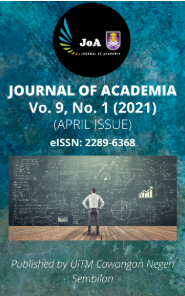DIVERSITY AND DISTRIBUTION OF FRESHWATER FISHES AT SUNGAI MUAR, KUALA PILAH, NEGERI SEMBILAN
Keywords:
diversity, distribution, freshwater fish, length-weight, Sg MuarAbstract
Freshwater fishes are species that spend their entire live in either freshwater inland or brackish estuaries. The checklist of the fish species should be updated consistently to ensure their diversity is preserved. The study of diversity and distribution of freshwater fishes at Sungai Muar, Kuala Pilah, Negeri Sembilan was carried out on 14 and 15 March 2020 to identify the fish diversity and their development in Sg. Muar, Negeri Sembilan. Trawl (fish collections), weighing machine and ruler (morphometric observations) was used during experiment. Fish species found during this study include Oreochromis mossambicus (Family Cichlidae), Hemibagrus nemurus (Family Bagridae), Homaloptera tweediei (Family Balitoridae), Notopterus notopterus (Family Notopteridae), Oxyeleotris marmorata (family Eleotridae), and five species of Family Cyprinidae, which were Mystacoleucus marginatus, Osteochilus haseltii, Cyclocheilichthys apogon, Barbonymus schwanenfeldii and Hampala microlepidota. Fishes from family Cyprinidae was dominated the area with a total of 102 individuals found. The statistical analysis shows the diversity (H’)=1.826, richness (R’)=2.004 and evenness (E’)= 0.5645 of freshwater fish at Sungai Muar, respectively. The most dominant species found was Mystacoleucus marginatus with 50 individuals and the least abundant species were Barbonymus schwanenfeldii, Homaloptera tweediei and Oxyeleotris marmorata with one individual only. The length-weight regression shows a positive allometric growth with ‘b’ value is higher than 3 at both stations; 3.0118 (Station 1) and 3.4409 (Station 2). It shows that the fish becomes heavier as its length increases. This data provides information about the fish habitat in Sungai Muar and can be used to update the checklist of fish species in Sg Muar. The data obtained provides information about the fish habitat in Sungai Muar which could be useful for the planning of fishing activities Other than that, it also important as a guideline for future research and conservation purposes especially in Negeri Sembilan.
References
Allan, J. D., Abell, R., Hogan, Z., Revenga, C., Taylor, B. W., Welcomme, R. L., & Winemiller, K. (2005). Overfishing of inland waters. BioScience, 55(12), 1041-1051. DOI: 10.1641/0006-3568(2005)055[1041:OOIW]2.0.CO;2
Aydin, H., Gaygusuz, O., Tarkan, A. S., Top, N., Emiroglu, O., & Gursoy Gaygusuz, C. (2011). Invasion of freshwater bodies in Marmara Region (NM-Turkey) by non-native Gibel carp, Carassius gibelio. Turkish Journal of Zoology, 35, 829-836. doi:10.3906/zoo-1007-31
BBC (2019). Geographical enquiry process. https://www.bbc.co.uk/bitesize/guides/z9st2nb/revision/4. [Access online 5 November 2019].
Beamish, F. W. H., Sa-ardrit, P., & Tongnunui, S. (2006). Habitat characteristics of the Cyprinidae in small rivers in Central Thailand. Environmental Biology of Fishes, 76(2-4), 237–253. DOI:10.1007/s10641-006-9029-0
Benstead, R. (2019). The freshwater fish crisis. https://www.technologynetworks.com/applied-sciences/articles/the-freshwater-fish-crisis-316375. [Access online 5 December 2019].
Chong, V. C., Lee, P. K., & Lau, C. M. (2010). Diversity, extinction risk and conservation of Malaysian fishes. Journal Fish Biology, 76(9), 2009-2066. DOI: 10.1111/j.1095-8649.2010.02685.x
Chow, V. K. K., Mohd Ismid, M. S., Maketab, M., & Shaikhah, S. (2016). Species composition and abundance of freshwater fishes in selected rivers of Johor, Malaysia. Int'l Journal of Research in Chemical, Metallurgical and Civil Engg. (IJRCMCE), 3(2), 214-218. http://dx.doi.org/10.15242/IJRCMCE.IAE0716411
Corse, E., Pech, N., Sinama, M., Costedoat, C., Chappaz, R., & Gilles, A. (2015). When anthropogenic river disturbance decreases hybridisation between non-native and endemic cyprinids and drives an ecomorphological displacement towards juvenile state in both species. PLoS ONE, 10(11), 0142592. doi:10.1371/journal.pone.0142592
Comte, L., Buisson, L., Daufresne, M., & Grenouillet, G. (2013). Climate‐induced changes in the distribution of freshwater fish: observed and predicted trends. Freshwater Biology, 58, 625–639. https://doi.org/10.1111/fwb.12081
Copp, G. H., Bianco, P. G., Bogutskaya, N., Eros, T., Falka, I., & Ferreira, M. T. (2005). To be, or not to be, a non-native freshwater fish?. Journal of Applied Ichthyology, 21, 242-262. DOI: 10.1111/j.1439-0426.2005.00690.x
Debashree, S. (2019). Types of aquatic ecosystems. https://sciencing.com/types-aquatic-ecosystems-6123685.html. [Access online 1 June 2020].
De Silva, S. S., Abery, N. W., & Nguyen, T. T. T. (2007). Endemic freshwater finfish of Asia: distribution and conservation status. Diversity and Distributions, 13(2), 172-184. https://doi.org/10.1111/j.1472-4642.2006.00311.x
Dudgeon, D., Arthington, A. H., Gessner, M. O., Kawabata, Z. I., Knowler, D. J., Lévêque, C., & Sullivan, C. A. (2005). Freshwater biodiversity: importance, threats, status and conservation challenges. Biological Reviews, 81(2), 163-182. https://doi.org/10.1017/S1464793105006950
Elith, J., & Leathwick, J. R. (2009). Species distribution models: ecological explanation and prediction across space and time. Annual review of ecology, evolution, and systematics, 40, 677-697. https://doi.org/10.1146/annurev.ecolsys.110308.120159
Fausch, K. D., Torgersen, C. E., Baxter, C. V., & Li, H. W. (2002). Landscapes to Riverscapes: bridging the gap between research and conservation of stream fishes: A continuous view of the river is needed to understand how processes interacting among scales set the context for stream fishes and their habitat. BioScience, 52(6), 483-498. https://doi.org/10.1641/0006-3568(2002)052[0483:LTRBTG]2.0.CO;2
Froese, R., & D. Pauly. (2019). FishBase, World Wide Web electronic application (version 08/2019). https://www.fishbase.de/. [Access online 2 December 2019].
Gaunle, K. (2018). How to calculate species evenness: Sciencing. https://sciencing.com/calculate-species-evenness-2851.html. [Access online 16 October 2019].
Geography Fieldwork (2016). Quantitative methods. Field studies council. https://www.geography-fieldwork.org/gcse/rivers/river-processes/fieldwork/#primary-nav. [Access online 5 November 2019].
Guisan, A., & Thuiller, W. (2005). Predicting species distribution: offering more than simple habitat models. Ecology letters, 8(9), 993-1009. DOI: 10.1111/j.1461-0248.2007.01044.x
Havel, J. E., Lee, C. E., & Vander Zanden, J. M. (2005). Do reservoirs facilitate invasions into landscapes? BioScience, 55(6), 518-525. https://doi.org/10.1641/0006-3568(2005)055[0518:DRFIIL]2.0.CO;2
International Union for Conservation of Nature. (2000). International Union for Conservation of Nature guidelines for the prevention of biodiversity loss caused by alien invasive species. 51st Meeting of the International Union for Conservation of Nature Council, Gland Switzerland.
Iglesias-Rios, R., & Mazzoni, R. (2014). Measuring diversity: looking for processes that generate diversity. Natureza & Conservação, 12(2), 156-161. https://doi.org/10.1016/j.ncon.2014.04.001
International Union for Conservation of Nature. (2019). Unsustainable fishing and hunting for bushmeat driving iconic species to extinction. IUCN Red List. https://www.iucn.org/news/species/201907/unsustainable-fishing-and-hunting-bushmeat-driving-iconic-species-extinction-iucn-red-list. [Access online 2 December 2019].
Jisr, N., Younes, G., Sukhn, C., & El-Dakdouki, M. H. (2018). Length-weight relationships and relative condition factor of fish inhabiting the marine area of the Eastern Mediterranean city, Tripoli-Lebanon. The Egyptian Journal of Aquatic Research, 44(4), 299-305. https://doi.org/10.1016/j.ejar.2018.11.004
Kenton, W. (2019). Goodness of fit. Investopedia. Retrieved June 22, 2020, from https://www.investopedia.com/terms/g/goodness-of-fit.asp
Khairul Adha, Rahim, A. R., Shabdin, Mohd Long & Fatimah, A. (2002). Survey of freshwater fish fauna in the upper rivers of Crocker range National park Sabah, Malaysia. ASEAN Review of Biodiversity and Environmental Conservation (ARBEC). ISSN 1823-3902
Khairul Adha, A. R., Siti Khalijah, D., Siti Shapor, S., Aziz, A., Yuzine, E., & Eza Rena, I. (2009). Freshwater fish diversity and composition in Batang Kerang floodplain, Balai Ringin, Sarawak. Pertanika Journal of Tropical Agricultural Science, 32(1), 7–16.
Kuriakose, S. (2014). Estimation of length-weight relationship in fishes. Fishery Resources Assessment Division: Training Manual on Fish Stock Assessment and Management, p 150.
Laurance, W. F., Sayer, J., & Cassman, K. G. (2014). Agricultural expansion and its impacts on tropical nature. Trends in Ecology and Evolution, 29(2), 107-116. DOI: 10.1016/j.tree.2013.12.001
Lammens, E. H. R. R., & Hoogenboezem, W. (1991) Diets and feeding behaviour. In: Winfield I.J., Nelson J.S. (eds) Cyprinid Fishes. Fish & Fisheries Series, vol 3. Springer, Dordrecht. https://doi.org/10.1007/978-94-011-3092-9_12
Lenntech (2020). Acids and alkalis in freshwater: Effects of changes in pH on freshwater ecosystems. https://www.lenntech.com/aquatic/acids-alkalis.htm. [Access online 4 June 2020].
Fish Mongabay (2007). List of freshwater fishes for Malaysia. https://fish.mongabay.com/data/Malaysia.htm. [Access online 10 June 2020].
FishBase. (2019). List of freshwater fishes reported from Malaysia. https://www.fishbase.se/country/CountryChecklist.php?resultPage=6&what=list&trpp=50&c_code=458&cpresence=Reported&sortby=alpha2&ext_CL=on&ext_pic=on&vhabitat=fresh. [Access online 4 May 2020].
Markovic, D., Walz, A., & Kärcher, O. (2019). Scale effects on the performance of niche-based models of freshwater fish distributions: Local vs. upstream area influences. Ecological Modelling, 411, 108818. https://doi.org/10.1016/j.ecolmodel.2019.108818
Margalef, R. (1958). Information theory in ecology. General Systems, 25(4), 393–399. https://doi.org/10.1016/S0097-8485(01)00073-0
Mojekwu, T. O. & Anumudu, C. l. (2015). Advanced techniques for morphometric analysis in fish. Journal of Aquaculture Research and Development, 6, 354. DOI: 10.4172/2155-9546.1000354
Morato, T., Afonso, P., Lourinho, P., Barreiros, J. P., Santos, R. S., & Nash, R. (2001). Length–weight relationships for 21 coastal fish species of the Azores, north-eastern Atlantic. Fisheries Research, 50(3), 297-302. https://doi.org/10.1016/S0165-7836(00)00215-0
Muchlisin, Z. A., Rinaldi, R., Fadli, N., Adlim, A., & Siti-Azizah, M. (2015). Food preference and diet overlap of two endemic and threatened freshwater fishes, Depik (Rasbora tawarensis) and Kawan (Poropuntius tawarensis) in Lake Laut Tawar, Indonesia. AACL Bioflux, 8(1), 40-49
Muchlisin, Z., & Siti-Azizah, M. (2009). Diversity and distribution of freshwater fishes in Aceh waters, Indonesia. International Journal of Zoological Research, 5, 62-79. DOI: 10.3923/ijzr.2009.62.79
Murthy, U., Fox, E. A., Chen, Y., Hallerman, E., da Silva Torres, R., Ramos, E. J., & Falcão, T. R. C. (2009). Superimposed image description and retrieval for fish species identification. Proceedings on Research and Advanced Technology for Digital Libraries, 13th European Conference, ECDL 2009, Corfu, Greece. DOI: 10.1007/978-3-642-04346-8_28
National Geographic. (2015). Freshwater fish. https://www.nationalgeographic.com/animals/fish/group/freshwater-fish/. [Access online 2 December 2020].
Nehemia, A., Maganira, J. D., & Rumisha, C. (2012). Length-weight relationship and condition factor of tilapia species grown in marine and freshwater ponds. Agriculture and Biology Journal of North America, 3(3),117-124 DOI: 10.5251/abjna.2012.3.3.117.124
Nur Hasyimah, R. (2008). Kepelbagaian taburan ikan air tawar di Cameron Highlands, Pahang. Graduate Theses and Dissertations, Universiti Kebangsaan Malaysia
Nur Hasyimah, R., Syakira, M. H., Mohd Syahril, M. Z., Samat, A., & Iwana, I. (2013). Water quality, diversity and distribution of freshwater fishes in, Negeri Sembilan. Journal of Academia, 3(1), 10-19.
Ogle, D. (2009). The effect of freezing on the length and weight measurements of Ruffe (Gymnocephalus cernuus). Fisheries Research, 99(3), 244–247. DOI: 10.1016/j.fishres.2009.06.009
Olurin, K. B., & Aderibigbe, O. A (2006). Length-weight relationship and condition factor of pond reared juvenile Oreochromis niloticus. Journal of Zoology, 1, 82-85.
Pandey, B. (2017). Morphometric study of fresh water Carps fishes of Shahdol Region. International Journal of Recent Research Aspects, 4(3), 146-152.
Rainboth, W. J. (1996). Fishes of the Cambodian Mekong. FAO Species identification field guide for fishery purposes. FAO, USA: Food and Agriculture Organization of the United Nation: pp. 1-265. http://library.enaca.org/inland/fishes-cambodian-mekong.pdf
Ronca, D. (2008). What's the biggest threat to freshwater habitats? Retrieved December 4, 2019 from https://adventure.howstuffworks.com/outdoor-activities/fishing/fish-conservation/fish-populations/freshwater habitat-threat.htm. [Access online 2 December 2020].
Shobha, R., Benakappa, S., Jitendra, K., A.S., Kumar, N., Gayatri, P., & Pema, C.W. (2017). Identification of fish stocks based on Truss Morphometric: A review. Journal of Fisheries and Life Sciences, 2(1), 9-14.
Simon, A., Britton, R., Gozlan, R., van Oosterhout, C., & Volckaert, F. A. M. (2011). Invasive Cyprinid fish in Europe originate from the single introduction of an admixed source population followed by a complex pattern of spread. PLOS ONE, 6(6), e18560. https://doi.org/10.1371/journal.pone.0018560
Sorte, C. J. B., Ibanez, I., Blumenthal, D. M., Molinari, N. A., Miller, L. P., Grosholz, E. D., Diez, J. M., D’Antonio, C. M., Olden, J. D., Jones, S. J. & Dukes, J.S. (2013). Poised to prosper? A cross-system comparison of climate change effects on native and non-native species performance. Ecology Letters, 16(2), 261-270. https://doi.org/10.1111/ele.12017
Tarkan, A. S., Gaygusuz, O., Gursoy Gaygusuz, C., Sac, G., & Copp, G. H. (2012). Circumstantial evidence of gibel carp, Carassius gibelio, reproductive competition exerted on native fish species in a mesotrophic reservoir. Fisheries Management and Ecology, 19(2), 167-166. https://doi.org/10.1111/j.1365-2400.2011.00839.x
Yanwirsal, H., Bartsch, P., & Kirschbaum, F. (2017). Reproduction and development of the Asian Bronze Featherback Notopterus notopterus (Pallas, 1769) (Osteoglossiformes, Notopteridae) in captivity. Zoosystematics and Evolution, 93(2), 299-324. DOI: 10.3897/zse.93.13341
Downloads
Published
Issue
Section
License
Copyright (c) 2021 Journal of Academia

This work is licensed under a Creative Commons Attribution-NonCommercial-NoDerivatives 4.0 International License.












